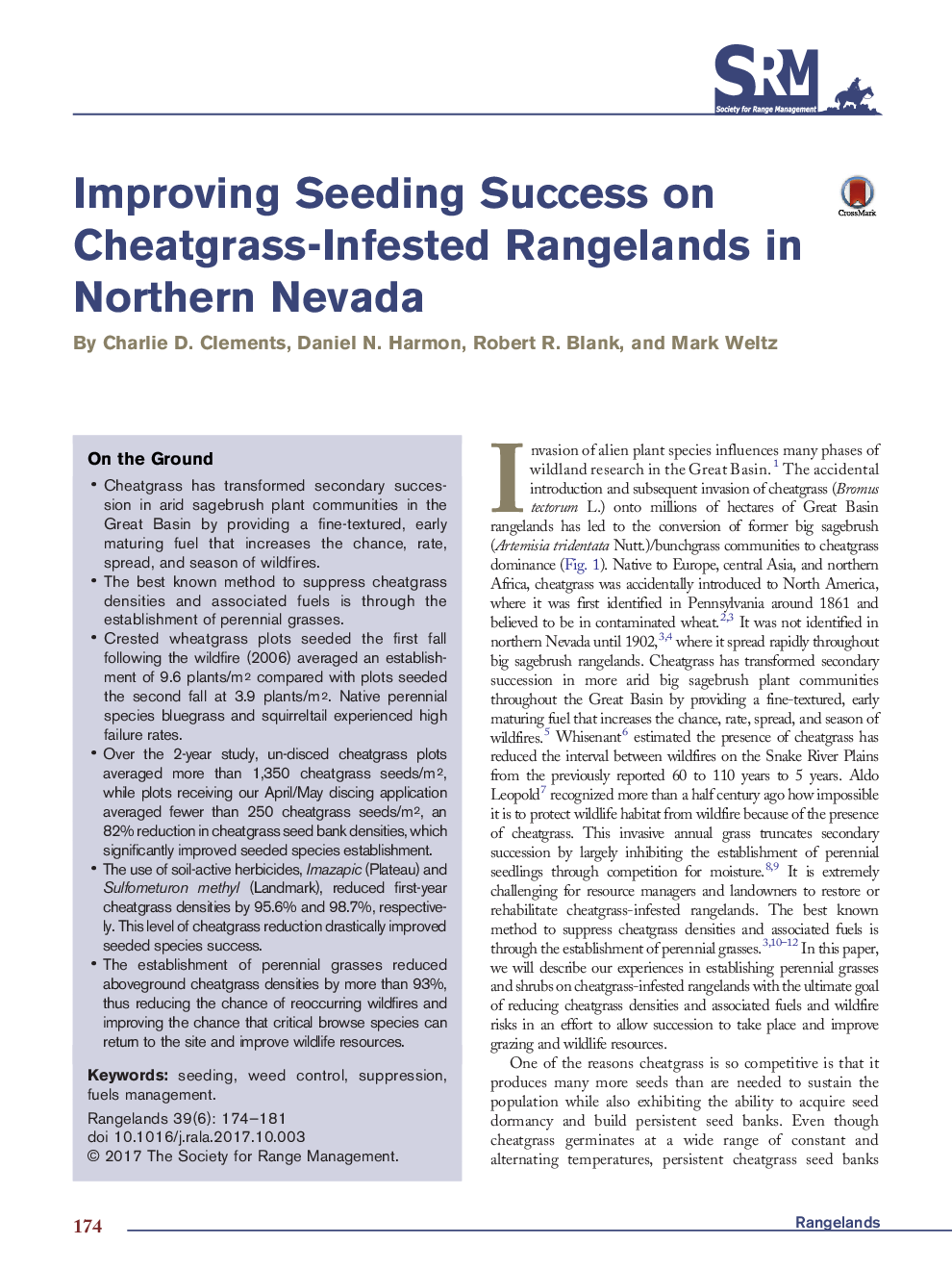| کد مقاله | کد نشریه | سال انتشار | مقاله انگلیسی | نسخه تمام متن |
|---|---|---|---|---|
| 8849684 | 1618652 | 2017 | 8 صفحه PDF | دانلود رایگان |
عنوان انگلیسی مقاله ISI
Improving Seeding Success on Cheatgrass-Infested Rangelands in Northern Nevada
دانلود مقاله + سفارش ترجمه
دانلود مقاله ISI انگلیسی
رایگان برای ایرانیان
کلمات کلیدی
موضوعات مرتبط
علوم زیستی و بیوفناوری
علوم کشاورزی و بیولوژیک
علوم کشاورزی و بیولوژیک (عمومی)
پیش نمایش صفحه اول مقاله

چکیده انگلیسی
On the Ground
- Cheatgrass has transformed secondary succession in arid sagebrush plant communities in the Great Basin by providing a fine-textured, early maturing fuel that increases the chance, rate, spread, and season of wildfires.
- The best known method to suppress cheatgrass densities and associated fuels is through the establishment of perennial grasses.
- Crested wheatgrass plots seeded the first fall following the wildfire (2006) averaged an establishment of 9.6 plants/m2 compared with plots seeded the second fall at 3.9 plants/m2. Native perennial species bluegrass and squirreltail experienced high failure rates.
- Over the 2-year study, un-disced cheatgrass plots averaged more than 1,350 cheatgrass seeds/m2, while plots receiving our April/May discing application averaged fewer than 250 cheatgrass seeds/m2, an 82% reduction in cheatgrass seed bank densities, which significantly improved seeded species establishment.
- The use of soil-active herbicides, Imazapic (Plateau) and Sulfometuron methyl (Landmark), reduced first-year cheatgrass densities by 95.6% and 98.7%, respectively. This level of cheatgrass reduction drastically improved seeded species success.
- The establishment of perennial grasses reduced aboveground cheatgrass densities by more than 93%, thus reducing the chance of reoccurring wildfires and improving the chance that critical browse species can return to the site and improve wildlife resources.
- Cheatgrass has transformed secondary succession in arid sagebrush plant communities in the Great Basin by providing a fine-textured, early maturing fuel that increases the chance, rate, spread, and season of wildfires.
- The best known method to suppress cheatgrass densities and associated fuels is through the establishment of perennial grasses.
- Crested wheatgrass plots seeded the first fall following the wildfire (2006) averaged an establishment of 9.6 plants/m2 compared with plots seeded the second fall at 3.9 plants/m2. Native perennial species bluegrass and squirreltail experienced high failure rates.
- Over the 2-year study, un-disced cheatgrass plots averaged more than 1,350 cheatgrass seeds/m2, while plots receiving our April/May discing application averaged fewer than 250 cheatgrass seeds/m2, an 82% reduction in cheatgrass seed bank densities, which significantly improved seeded species establishment.
- The use of soil-active herbicides, Imazapic (Plateau) and Sulfometuron methyl (Landmark), reduced first-year cheatgrass densities by 95.6% and 98.7%, respectively. This level of cheatgrass reduction drastically improved seeded species success.
- The establishment of perennial grasses reduced aboveground cheatgrass densities by more than 93%, thus reducing the chance of reoccurring wildfires and improving the chance that critical browse species can return to the site and improve wildlife resources.
ناشر
Database: Elsevier - ScienceDirect (ساینس دایرکت)
Journal: Rangelands - Volume 39, Issue 6, December 2017, Pages 174-181
Journal: Rangelands - Volume 39, Issue 6, December 2017, Pages 174-181
نویسندگان
Charlie D. Clements, Daniel N. Harmon, Robert R. Blank, Mark Weltz,